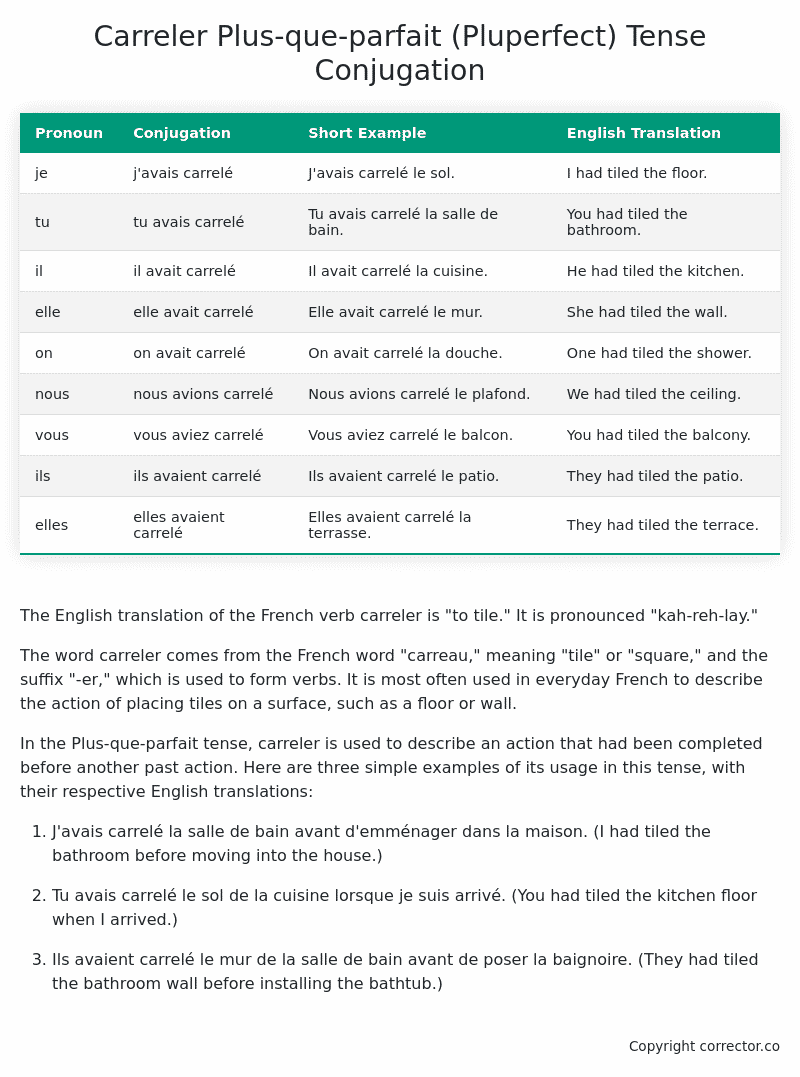Plus-que-parfait (Pluperfect) Tense Conjugation of the French Verb carreler
Introduction to the verb carreler
The English translation of the French verb carreler is “to tile.” It is pronounced “kah-reh-lay.”
The word carreler comes from the French word “carreau,” meaning “tile” or “square,” and the suffix “-er,” which is used to form verbs. It is most often used in everyday French to describe the action of placing tiles on a surface, such as a floor or wall.
In the Plus-que-parfait tense, carreler is used to describe an action that had been completed before another past action. Here are three simple examples of its usage in this tense, with their respective English translations:
-
J’avais carrelé la salle de bain avant d’emménager dans la maison. (I had tiled the bathroom before moving into the house.)
-
Tu avais carrelé le sol de la cuisine lorsque je suis arrivé. (You had tiled the kitchen floor when I arrived.)
-
Ils avaient carrelé le mur de la salle de bain avant de poser la baignoire. (They had tiled the bathroom wall before installing the bathtub.)
Table of the Plus-que-parfait (Pluperfect) Tense Conjugation of carreler
| Pronoun | Conjugation | Short Example | English Translation |
|---|---|---|---|
| je | j’avais carrelé | J’avais carrelé le sol. | I had tiled the floor. |
| tu | tu avais carrelé | Tu avais carrelé la salle de bain. | You had tiled the bathroom. |
| il | il avait carrelé | Il avait carrelé la cuisine. | He had tiled the kitchen. |
| elle | elle avait carrelé | Elle avait carrelé le mur. | She had tiled the wall. |
| on | on avait carrelé | On avait carrelé la douche. | One had tiled the shower. |
| nous | nous avions carrelé | Nous avions carrelé le plafond. | We had tiled the ceiling. |
| vous | vous aviez carrelé | Vous aviez carrelé le balcon. | You had tiled the balcony. |
| ils | ils avaient carrelé | Ils avaient carrelé le patio. | They had tiled the patio. |
| elles | elles avaient carrelé | Elles avaient carrelé la terrasse. | They had tiled the terrace. |
Other Conjugations for Carreler.
Le Present (Present Tense) Conjugation of the French Verb carreler
Imparfait (Imperfect) Tense Conjugation of the French Verb carreler
Passé Simple (Simple Past) Tense Conjugation of the French Verb carreler
Passé Composé (Present Perfect) Tense Conjugation of the French Verb carreler
Futur Simple (Simple Future) Tense Conjugation of the French Verb carreler
Futur Proche (Near Future) Tense Conjugation of the French Verb carreler
Plus-que-parfait (Pluperfect) Tense Conjugation of the French Verb carreler (this article)
Passé Antérieur (Past Anterior) Tense Conjugation of the French Verb carreler
Futur Antérieur (Future Anterior) Tense Conjugation of the French Verb carreler
Subjonctif Présent (Subjunctive Present) Tense Conjugation of the French Verb carreler
Subjonctif Passé (Subjunctive Past) Tense Conjugation of the French Verb carreler
Subjonctif Imparfait (Subjunctive Imperfect) Tense Conjugation of the French Verb carreler
Subjonctif Plus-que-parfait (Subjunctive Pluperfect) Tense Conjugation of the French Verb carreler
Conditionnel Présent (Conditional Present) Tense Conjugation of the French Verb carreler
Conditionnel Passé (Conditional Past) Tense Conjugation of the French Verb carreler
L’impératif Présent (Imperative Present) Tense Conjugation of the French Verb carreler
L’infinitif Présent (Infinitive Present) Tense Conjugation of the French Verb carreler
Struggling with French verbs or the language in general? Why not use our free French Grammar Checker – no registration required!
Get a FREE Download Study Sheet of this Conjugation 🔥
Simply right click the image below, click “save image” and get your free reference for the carreler Plus-que-parfait tense conjugation!

Carreler – About the French Plus-que-parfait (Pluperfect) Tense
Tense Formation
Common everyday usage patterns
Sequencing of past events
Background information
Hypothetical or reported speech
Interactions with other tenses
Summary
I hope you enjoyed this article on the verb carreler. Still in a learning mood? Check out another TOTALLY random French verb conjugation!


